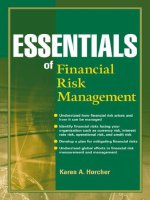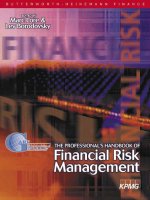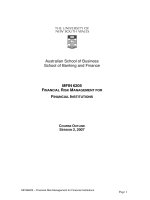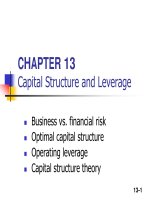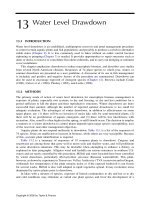Elements of financial risk management chapter 13
Bạn đang xem bản rút gọn của tài liệu. Xem và tải ngay bản đầy đủ của tài liệu tại đây (618.09 KB, 74 trang )
1
Backtesting and Stress Testing
Elements of
Financial Risk Management
Chapter 13
Peter Christoffersen
Elements of Financial Risk Management Second Edition © 2012 by Peter Christoffersen
Overview
2
• The objective in this chapter is to consider the ex ante risk
measure forecasts from the model and compare them with
the ex post realized portfolio return
• The risk measure forecast could take the form of a Value-atRisk (VaR), an Expected Shortfall (ES), the shape of the
entire return distribution, or perhaps the shape of the left tail
of the distribution only
• We want to be able to backtest any of these risk measures of
interest
• The backtest procedures can be seen as a final diagnostic
check on the aggregate risk model, thus complementing the
other various specific diagnostics
Elements of Financial Risk Management Second Edition © 2012 by Peter Christoffersen
Overview
3
• The material in the chapter will be covered as follows:
• We take a brief look at the performance of some real-life
VaRs from six large commercial banks
• The clustering of VaR violations in these real-life VaRs
provides sobering food for thought
• We establish procedures for backtesting VaRs
• We start by introducing a simple unconditional test for the
average probability of a VaR violation
• We then test the independence of the VaR violations
• Finally, combine unconditional test and independence test in a
test of correct conditional VaR coverage
Elements of Financial Risk Management Second Edition © 2012 by Peter Christoffersen
Overview
4
• We consider using explanatory variables to backtest the VaR
• This is done in a regression-based framework
• We establish backtesting procedures for the Expected
Shortfall measure
• We broaden the focus to include the entire shape of the
distribution of returns
• The distributional forecasts can be backtested as well, and
we suggest ways to do so
• Risk managers typically care most about having a good
forecast of the left tail of the distribution
Elements of Financial Risk Management Second Edition © 2012 by Peter Christoffersen
Overview
5
• We therefore modify the distribution test to focus on
backtesting the left tail of the distribution only
• We define stress testing and give a critical survey of the
way it is often implemented
• Based on this critique we suggest a coherent framework for
stress testing
• Figure 13.1 shows the performance of some real-life VaRs
• Figure shows the exceedances of the VaR in six large U.S.
commercial banks during the January 1998 to March 2001
period
Elements of Financial Risk Management Second Edition © 2012 by Peter Christoffersen
Figure 13.1: Value-at-Risk Exceedences From Six
Major Commercial Banks
Elements of Financial Risk Management Second Edition © 2012 by Peter Christoffersen
6
Overview
• Whenever the realized portfolio return is worse than the
VaR, the difference between the two is shown
• Whenever the return is better, zero is shown
• The difference is divided by the standard deviation of the
portfolio across the period
• The return is daily, and the VaR is reported for a 1%
coverage rate.
• To be exact, we plot the time series of
Elements of Financial Risk Management Second Edition © 2012 by Peter Christoffersen
7
Overview
8
• Bank 4 has no violations at all, and in general the banks
have fewer violations than expected
• Thus, the banks on average report a VaR that is higher than
it should be
• This could either be due to the banks deliberately wanting
to be cautious or the VaR systems being biased
• Another culprit is that the returns reported by the banks
contain nontrading-related profits, which increase the
average return without substantially increasing portfolio
risk
Elements of Financial Risk Management Second Edition © 2012 by Peter Christoffersen
Overview
9
• More important, notice the clustering of VaR violations
• The violations for each of Banks 1, 2, 3, 5, and 6 fall within
a very short time span and often on adjacent days
• This clustering of VaR violations is a serious sign of risk
model misspecification
• These banks are most likely relying on a technique such as
Historical Simulation (HS), which is very slow at updating
the VaR when market volatility increases
• This issue was discussed in the context of the 1987 stock
market crash in Chapter 2
Elements of Financial Risk Management Second Edition © 2012 by Peter Christoffersen
Overview
10
• Notice also how the VaR violations tend to be clustered
across banks
• Many violations appear to be related to the Russia default
and Long Term Capital Management bailout in the fall of
1998
• The clustering of violations across banks is important from a
regulator perspective because it raises the possibility of a
countrywide banking crisis
• Motivated by the sobering evidence of misspecification in
existing commercial bank VaRs, we now introduce a set of
statistical techniques for backtesting risk management
models
Elements of Financial Risk Management Second Edition © 2012 by Peter Christoffersen
Backtesting VaRs
11
• Recall that a VaRpt+1 measure promises that the actual return
will only be worse than the VaRpt+1 forecast p . 100% of the
time
• If we observe a time series of past ex ante VaR forecasts and
past ex post returns, we can define the “hit sequence” of
VaR violations as
Elements of Financial Risk Management Second Edition © 2012 by Peter Christoffersen
Backtesting VaRs
12
• The hit sequence returns a 1 on day t+1 if the loss on that
day was larger than the VaR number predicted in advance
for that day
• If the VaR was not violated, then the hit sequence returns a
0
• When backtesting the risk model, we construct a sequence
.
across T days indicating when the past
violations occurred
Elements of Financial Risk Management Second Edition © 2012 by Peter Christoffersen
The Null Hypothesis
13
• If we are using the perfect VaR model, then given all the
information available to us at the time the VaR forecast is
made, we should not be able to predict whether the VaR
will be violated
• Our forecast of the probability of a VaR violation should be
simply p every day
• If we could predict the VaR violations, then that
information could be used to construct a better risk model
Elements of Financial Risk Management Second Edition © 2012 by Peter Christoffersen
The Null Hypothesis
14
• The hit sequence of violations should be completely
unpredictable and therefore distributed independently over time
as a Bernoulli variable that takes the value 1 with probability p
and the value 0 with probability (1-p)
• We write:
• If p is 1/2, then the i.i.d. Bernoulli distribution describes
the distribution of getting a “head” when tossing a fair
coin.
• The Bernoulli distribution function is written
Elements of Financial Risk Management Second Edition © 2012 by Peter Christoffersen
The Null Hypothesis
15
• When backtesting risk models, p will not be 1/2 but instead
on the order of 0.01 or 0.05 depending on the coverage rate
of the VaR
• The hit sequence from a correctly specified risk model
should thus look like a sequence of random tosses of a
coin, which comes up heads 1% or 5% of the time
depending on the VaR coverage rate
Elements of Financial Risk Management Second Edition © 2012 by Peter Christoffersen
Unconditional Coverage Testing
16
• We first want to test if the fraction of violations obtained for
a particular risk model, call it , is significantly different
from the promised fraction, p
• We call this the unconditional coverage hypothesis
• To test it, we write the likelihood of an i.i.d. Bernoulli() hit
sequence
• where T0 and T1 are number of 0s and 1s in sample
• We can easily estimate from
; that is, the
observed fraction of violations in the sequence
Elements of Financial Risk Management Second Edition © 2012 by Peter Christoffersen
Unconditional Coverage Testing
17
• Plugging the maximum likelihood (ML) estimates back into
the likelihood function gives the optimized likelihood as
• Under the unconditional coverage null hypothesis that
=p, where p is the known VaR coverage rate, we have the
likelihood
• We can check the unconditional coverage hypothesis using
a likelihood ratio test
Elements of Financial Risk Management Second Edition © 2012 by Peter Christoffersen
Unconditional Coverage Testing
18
• Asymptotically, that is, as the number of observations, T,
goes to infinity, the test will be distributed as a 2 with one
degree of freedom
• Substituting in the likelihood functions, we write
• The larger the LRuc value is the more unlikely the null
hypothesis is to be true
• Choosing a significance level of say 10% for the test, we
will have a critical value of 2.7055 from the 21
distribution
Elements of Financial Risk Management Second Edition © 2012 by Peter Christoffersen
Unconditional Coverage Testing
19
• If the LRuc test value is larger than 2.7055, then we reject
the VaR model at the 10% level
• Alternatively, we can calculate the P-value associated with
our test statistic
• The P-value is defined as the probability of getting a
sample that conforms even less to the null hypothesis than
the sample we actually got given that the null hypothesis is
true
Elements of Financial Risk Management Second Edition © 2012 by Peter Christoffersen
Unconditional Coverage Testing
20
• In this case, the P-value is calculated as
• Where
denotes the cumulative density function of a
2 variable with one degree of freedom
• If the P-value is below the desired significance level, then
we reject the null hypothesis
• If we, for example, obtain a test value of 3.5, then the
associated P-value is
Elements of Financial Risk Management Second Edition © 2012 by Peter Christoffersen
Unconditional Coverage Testing
21
• If we have a significance level of 10%, then we would
reject the null hypothesis, but if our significance level is
only 5%, then we would not reject the null that the risk
model is correct on average
• The choice of significance level comes down to an
assessment of the costs of making two types of mistakes:
• We could reject a correct model (Type I error) or we could
fail to reject (that is, accept) an incorrect model (Type II
error).
• Increasing the significance level implies larger Type I
errors but smaller Type II errors and vice versa
Elements of Financial Risk Management Second Edition © 2012 by Peter Christoffersen
Unconditional Coverage Testing
22
• In academic work, a significance level of 1%, 5%, or 10% is
typically used
• In risk management, Type II errors may be very costly so
that a significance level of 10% may be appropriate
• Often, we do not have a large number of observations
available for backtesting, and we certainly will typically not
have a large number of violations, T1, which are the
informative observations
• It is therefore often better to rely on Monte Carlo simulated
P-values rather than those from the 2 distribution
Elements of Financial Risk Management Second Edition © 2012 by Peter Christoffersen
Unconditional Coverage Testing
23
• The simulated P-values for a particular test value can be
calculated by first generating 999 samples of random i.i.d.
Bernoulli(p) variables, where the sample size equals the
actual sample at hand.
• Given these artificial samples we can calculate 999
simulated test statistics, call them
• The simulated P-value is then calculated as the share of
simulated LRuc values that are larger than the actually
obtained LRuc test value
Elements of Financial Risk Management Second Edition © 2012 by Peter Christoffersen
Unconditional Coverage Testing
24
• We can write
• where 1() takes on the value of one if the argument is true
and zero otherwise
• To calculate the tests in the first place, we need samples
where VaR violations actually occurred; that is, we need
some ones in the hit sequence
• If we, for example, discard simulated samples with zero or
one violations before proceeding with the test calculation,
then we are in effect conditioning the test on having
observed at least two violations
Elements of Financial Risk Management Second Edition © 2012 by Peter Christoffersen
Independence Test
25
• We should be concerned if all of the VaR violations or “hits”
in a sample are happening around the same time which was
the case in Figure 13.1
• If the VaR violations are clustered then the risk manager can
essentially predict that if today is a violations, then tomorrow
is more than p.100% likely to be a violation as well. This is
clearly not satisfactory.
• In such a situation the risk manager should increase the VaR
in order to lower the conditional probability of a violation to
the promised p
• Our task is to establish a test which will be able to reject VaR
with clustered violations
Elements of Financial Risk Management Second Edition © 2012 by Peter Christoffersen

